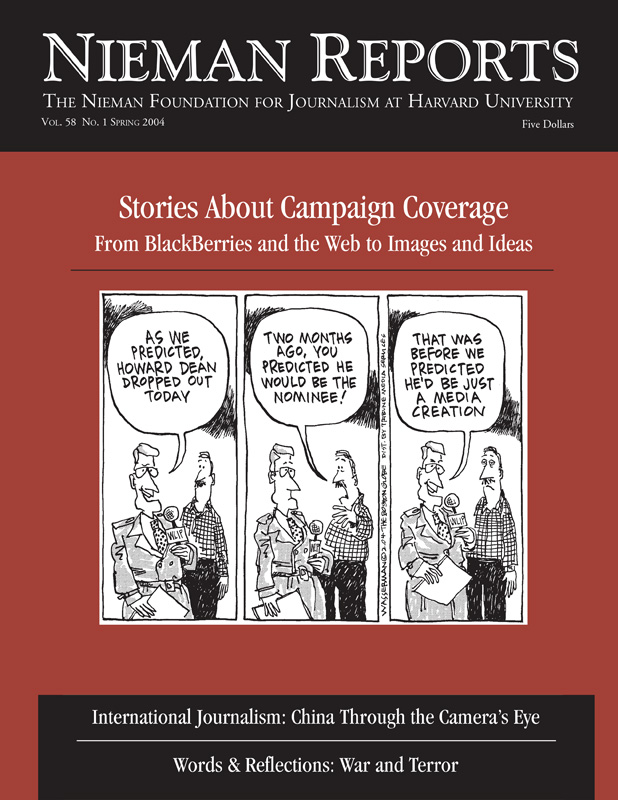The confluence of politics, photojournalism and ethics creates a strange potion. During the campaign season those who take photos and those who make decisions about which ones to publish confront some difficult challenges. Among the tougher ones is the constant need to determine whether the strategic staging of events interferes with the journalist’s mission to provide an accurate portrayal of the day’s events. One reason such deliberations are essential is that in our visually driven culture, images drive voters’ decisions and sway public opinion. And a photographic image can be more powerful in its message-sending capacity than the ephemeral glimpse of a few frames from the same event shown in a video report.
Though it was not called a “campaign event,” President Bush traveled secretly on Thanksgiving Day to visit the U.S. troops in Baghdad. And the still image that emerged from that day’s trip—a photograph published in newspapers throughout the world—was of the commander in chief smiling broadly as he carried a giant turkey to the troops on a silver platter. That the soldiers didn’t actually eat that turkey (it was a decorative one) or even share their meal with the President, who was on his way home soon after he arrived, were subtleties lost as the power of the image subsumed such details.
Pablo Martinez Monsivais, The Associated Press’s photographer, was one of the five photographers on that trip. “We had no idea that the President would do what he did once we entered the mess hall,” recalls Monsivais. Though some who were with the President in Iraq believe this photograph captured a spontaneous moment, others have doubts. But there was no question that it was the evocative picture to come out of the event.
How then do photo editors decide whether such a photograph is appropriate to use, when it is known how hard the Bush team works to orchestrate photo ops and maintain control over the President’s image?
In this situation, several key considerations and questions are raised in deciding whether to take and/or publish this photograph.
- Because most political events are staged to some degree, photographers and editors need to reflect on whether the staging involved in producing this image is acceptable in letting them meet their obligation of accuracy.
- If photo editors knew at that time that the turkey platter photograph was set up to some degree, should they have used it?
- Should a caption be used to clarify what the photo is showing?
- What if a photographer writes an accurate caption, but the photo gets picked up and used by newspapers without the clarifying text accompanying it?
- If a photographer decided the visual image was a staged set-up shot and decided not to take the photograph, what would happen to this photographer when his press pool colleagues take the picture and theirs appear on the front pages of newspapers the next day? How will his paper or news service react?
How photographers and editors resolve these issues will vary, but what remains constant is the intensity of pressures faced by both of these journalists to bring people compelling, evocative and dramatic images. And the commercial forces with which photographers and editors contend are so strong, too, that often a photograph like the one from Baghdad will be taken and published, even when one concludes that it was staged.
To gain the kind of access photographers need to capture more genuine moments from a campaign, they need to negotiate with candidates and their staff to gain access that goes beyond staged events. This requires delicate balancing of building relationships while at the same time maintaining editorial independence. But our credibility relies on our audience’s belief in the accuracy of what they see.
Here are a few questions photo editors might ask as a way of ensuring that their newspapers’ images will offer readers a fair and accurate view of the day’s political events:
- Have I taken the necessary steps to provide balanced coverage with respect to various candidates?
- Have I talked with the photographer about these issues? Do I trust the photographer to make good news decisions?
- Have I considered publishing explanatory captions? These captions could illuminate how the photograph came to be taken, which might not be apparent by looking at it. Would such captions help put the image into a broader, more accurate context?
As the Election Day approaches, Americans will sift through lots of images. They ought to be able to trust that photographers and editors have thought enough about their choices to give them ones that illuminate what they need to know about the candidates and how they present themselves to the people.
Kenny Irby is visual journalism group leader at The Poynter Institute for Media Studies.


